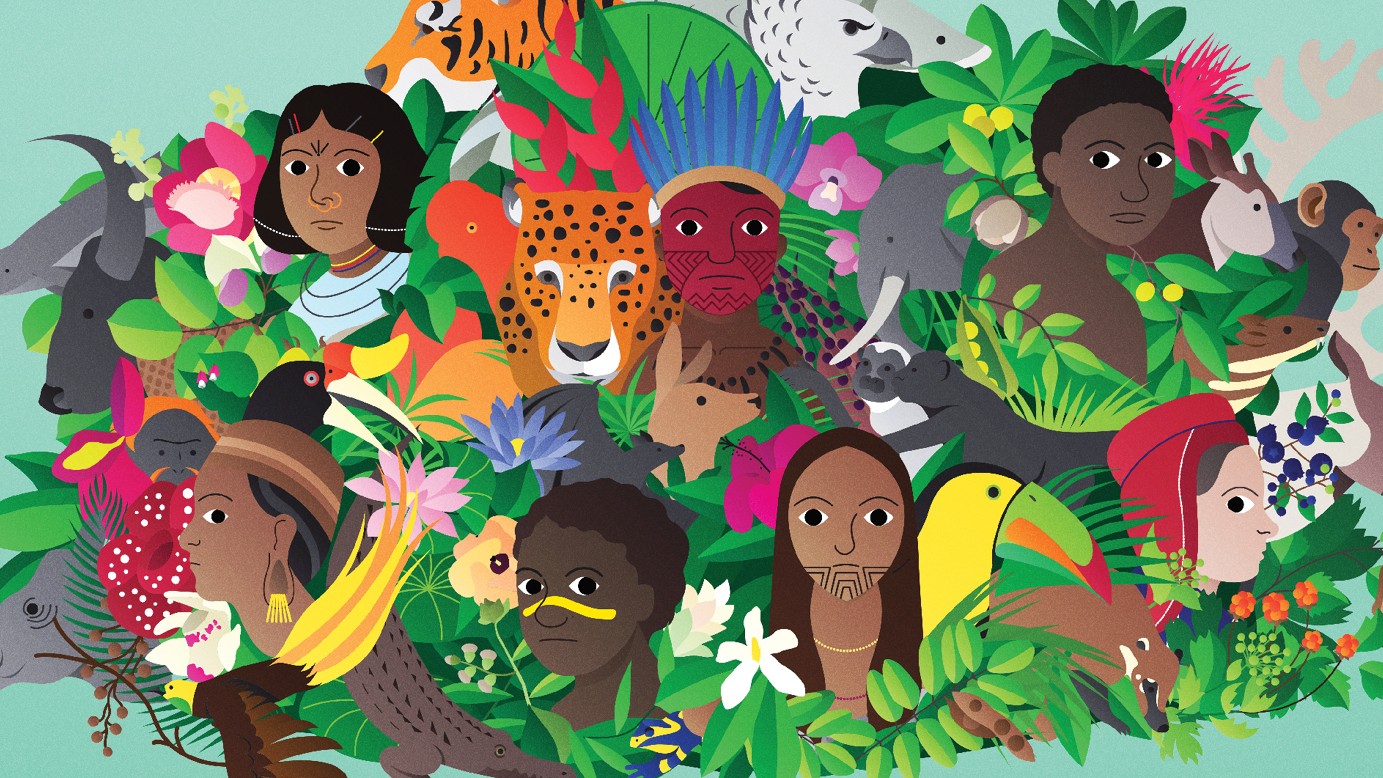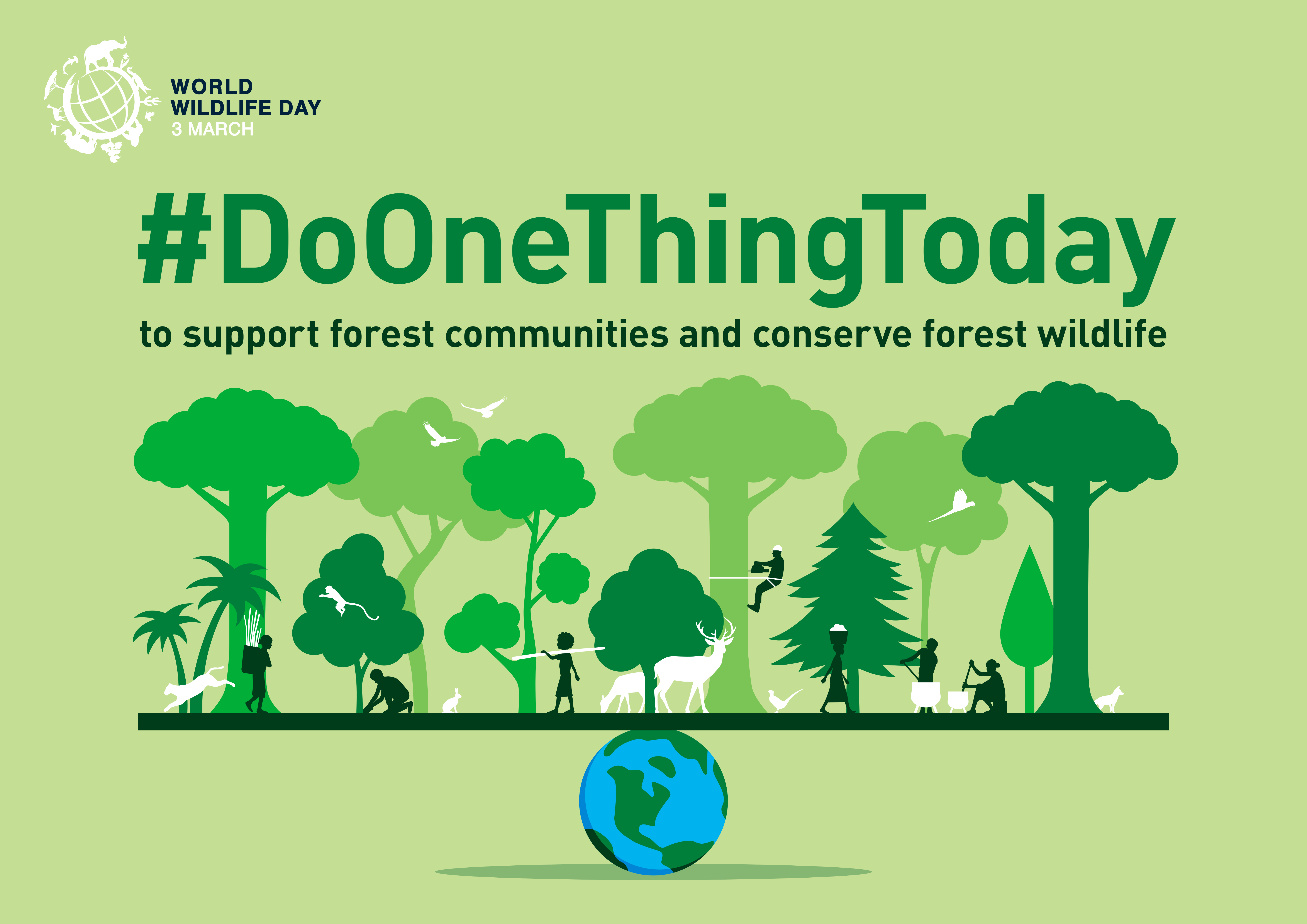
World Wildlife Day 2021 -- 3 March 2021
World Wildlife Day will be celebrated in 2021 under the theme "Forests and Livelihoods: Sustaining People and Planet", as a way to highlight the central role of forests, forest species and ecosystems services in sustaining the livelihoods of hundreds of millions of people globally, and particularly of Indigenous and local communities with historic ties to forested and forest-adjacent areas.
Forests, forests species and the livelihoods that depend on them currently find themselves at the crossroads of the multiple planetary crises we currently face, from climate change, to biodiversity loss and the health, social and economic impacts of the COVID-19 pandemic.
Sustainable wildlife management is the sound management of wildlife species to sustain their populations and habitat over time, considering the socioeconomic needs of human populations. Between 200 and 350 million people live within or adjacent to forested areas around the world, relying on the various ecosystem services provided by forest and forest species for their livelihoods and to cover their most basic needs, including food, shelter, energy and medicines.
To fully ensure a sustainable future for forests and livelihoods, indigenous peoples and local communities (IPLCs) need to be engaged. As noted in the second edition of the Local Biodiversity Outlooks (LBO-2), the relation between IPLCs and wildlife is tied to their traditional knowledge and customary sustainable use of biodiversity.
As Parties to the Convention on Biological Diversity discuss the post-2020 global biodiversity framework, to be agreed later this year in Kunming, China, we have an important opportunity before us to highlight “sustainable wildlife management” as an essential tool to conserve biodiversity and for maintaining and enhancing forest ecosystem services.

Celebrations
On March 3 2021, World Wildlife Day will celebrate forest-based livelihoods and seek to promote forest and forest wildlife management models and practices that accommodate both human well-being and the long-term conservation of forests, forest-dwelling species of wild fauna and flora and the ecosystems they sustain, and promote the value of traditional practices and knowledge that contribute to establishing a more sustainable relationship with these crucial natural systems.
Virtual Event
This year will feature the first-ever virtual celebration of the United Nations’ World Wildlife Day! UN member States, UN System organizations and multilateral environmental agreements, civil society, and the private sector will be brought together for a series of discussions along the theme of "Forests and Livelihoods: Sustaining People and Planet".
We will highlight the experiences and knowledge of IPLCs whose livelihoods rely on forests and wildlife, and who have a long history of managing and sustainably using forest ecosystems.
Publishing the Digital Version of LBO-2
The theme of this year’s World Wildlife Day, "Forests and livelihoods: Sustaining People and Planet", foregrounds the importance of IPLCs, as well as the challenges they face. On this World Wildlife Day, International Indigenous Forum on Biodiversity, the Indigenous Women’s Biodiversity Network, the Centres of Distinction on Indigenous and Local Knowledge, Forest Peoples Programme and the Secretariat of the Convention on Biological Diversity are marking the occasion by publishing the digital version of Local Biodiversity Outlooks 2 (LBO-2) in English, Spanish and French.
LBO-2 is a landmark piece of collaborative research and analysis that features contributions from over 50 indigenous and local authors and communities. The report highlights the critical roles played by IPLCs in maintaining and enhancing biological and cultural diversity and outlines indigenous and local perspectives on the transformational changes needed in order to realise the vision of a world living in harmony with nature.
Click here to visit the new microsite with the digital version of LBO-2
A World Without Nature
We all depend on nature—for inspiration, air, water, food, and more. So, what would a world without nature look like?
On World Wildlife Day, CBD will join World Wildlife Fund in removing nature from our branding. Together, we seek to highlight the dramatic loss of biodiversity globally and the social and economic risks it poses.
The leaves in CBD logo will disappear for the first time, on our social media accounts. The #WorldWithoutNature campaign brings together more than 100 famous brands and sports teams in a common cause - speaking up for nature.
More Information:
Sustainable Wildlife Management
Local Biodiversity Outlooks 2: Digital Version
Facts to think about on World Wildlife Day
- As many as 350 million people live within or adjacent to forested areas around the world. They rely on the ecosystem services provided by forests and forest species to meet their essential needs.
- For centuries, forests have acted as a safety net for hundreds of millions of people, providing sustenance, fuel and medicines, and feeding animals communities depend on when crops fail.
- The economic effects of COVID-19 threaten both forest livelihoods and the incentives for the conservation of these ecosystems. Plans for recovery must include efforts to preserve forests, forest species and livelihoods.
- Globally, up to 1.6 billion people, including many of the poorest communities on the planet, rely on forests and forest species for subsistence, livelihoods and income generation.
- About 2.4 billion people, a third of the world’s population, use wood fuel for basic energy needs such as cooking, sterilizing water or heating homes.
- Nearly a third of the world’s land surface is currently managed by indigenous peoples. This includes some of the most ecologically intact forest ecosystems on the planet.
- Over 300 million members of Indigenous peoples and local communities from around the world live in forests and primarily depend on them for their livelihoods.
- Nearly all forests on the planet are inhabited, with indigenous and other groups having developed unique ways of life and knowledge of how to sustainably use and conserve forest species and ecosystems.
- Forests are home to 80% of all terrestrial wildlife. The ecosystems they sustain are essential to global biodiversity, human livelihoods and the broader needs of societies and economies globally.
- Roughly 66% of the world’s forest area lies within the territories of just 10 countries: Russia, Brazil, Canada, USA, China, Australia, DRC, Indonesia, Peru and India
- Forests absorb nearly one-third of all CO2 released from burning fossil fuels every year. Forest restoration could remove another 26 gigatons of greenhouse gases from the atmosphere.
- Forest loss, degradation and fragmentation accelerate climate breakdown and of biodiversity loss. This threatens the global food and water security and it imperils the safety and the livelihoods of millions of people.
- About half of the world’s tropical forests are considered intact, but less than 7% of these forests are under some form of legal protection.
- We currently face a quadruple planetary emergency: a climate crisis, a biodiversity-loss crisis, an inequality crisis, and a global health crisis. Forests and forest communities are at the center of each of these challenges